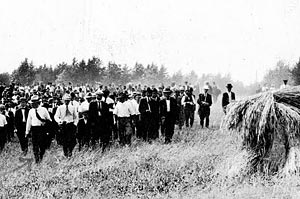Spooner research station marks centennial
On Tuesday, Oct. 20, UW–Madison’s Spooner Agricultural Research Station will celebrate its 100th birthday and commemorate a milestone in the history of Wisconsin agriculture.

A.R. Whitson, professor of agricultural physics at the University of Wisconsin, leads a field day at Spooner, circa 1912. See more historical photos.
Photo: courtesy the College of Agricultural and Life Sciences
Founded in 1909, the Spooner research station was UW–Madison’s first permanent branch research station — the beginning of a network of stations established across Wisconsin to facilitate research under a variety of growing conditions. By 1923, the university also had stations at Ashland, Marshfield, Hancock and Sturgeon Bay. Today it operates 11 off-campus stations, some in cooperation with USDA, on about 8,000 acres across the state.
The public is invited to visit the Spooner station from 1-4 p.m. on Oct. 20 to join in the celebration and learn about the station’s history and accomplishments.
When it established the Spooner operation, the university had been operating an experimental farm on the Madison campus for 40 years. But as farming took hold in the upper half of the state, it became apparent that lessons learned on southern Wisconsin’s prairie soils didn’t always apply up north, where the season was shorter and soils ranged from light sand to heavy clay.
So, as directed by the state Legislature, the university set out to open branch stations on soils that were “materially different from that which obtains at the central station in Madison,” noted Harry L. Russell, dean of the university’s College of Agriculture, in his 1910 annual report.
About 230 miles north of Madison, the Spooner site consisted of 80 acres of sandy soils and jack pine forest representative of more than 2 million acres of northern Wisconsin.
“An attempt will be made…to see if lands of this character cannot be handled in such as way as to make them more productive…where present methods of farming largely result in a quick depletion of the low initial fertility of these soils,” Russell wrote.
A year later, the trees had been cut, the stumps cleared, the ground broken, and “an 80-bushel corn crop produced on manured clover sod,” Russell reported.
Since then the facility has grown to 383 acres and has been home to a wide array of crop and livestock research, says Phil Holman, the station’s superintendent. It also serves as a regional education center. Both UW–Madison and UW-Extension educators are based there.
Early on, Spooner researchers produced lines of open-pollinated corn, oats and soybeans that were widely adopted. In 1923, they began work that yielded 80- and 85-day hybrids that helped make corn an important crop in northern Wisconsin and other areas with short growing seasons. At the end of World War II, Spooner staff were overseeing the production of hybrid foundation seed corn grown on up to 3,700 acres in the area.
Today the agronomic program has been expanded to look at crops such as canola, sunflowers, and switchgrass for biofuel.
Sheep research began at Spooner in 1936 and has ranged from pasture studies to introduction of the Targhee breed to Wisconsin. The station has hosted an annual sheep field day for 57 years, and in 1995 it began what quickly became the nation’s leading dairy sheep research program.
The program on Oct. 20 will feature remarks by Molly Jahn, dean of the UW–Madison College of Agricultural and Life Sciences, as well as presentations by station staff on the milestones in the station’s history, it’s current work and plans for the future.
The Spooner Station is located just east of Spooner on Highway 70. For more information, contact the station at 715-635-3735.




